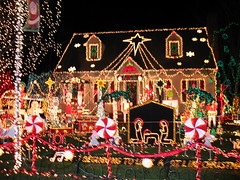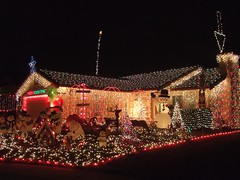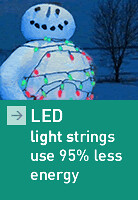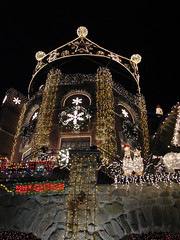Considering that Lowell put up pretty Arlington lights the other day …
Do you love those displays of Christmas (or Hannukah or Kwanza or …) lights? Are you awed by those so impassioned that they string up 1000s of lights in awesome displays worthy of a city center? I once did, pausing on cold winter nights, white clouds issuing from my mouth, enjoying being in the glow of beautiful displays. And, in a way, I was inspired that they would spend $1000s (or $10,000s) on displays and the electricity to power them so that others could enjoy the sight on those cold winter nights.
But … no longer … not for awhile. Far too often nowadays, my winter evenings I can wear short sleeve shirts  rather than bulky coats and gloves. And, energy is no longer a question simply of money. I’ve reached the point of feeling like a Scrooge; feeling outrage over the tons of C02 going into the atmosphere via neighbors’ 10,000 light displays rather than feeling ‘joyous’.
rather than bulky coats and gloves. And, energy is no longer a question simply of money. I’ve reached the point of feeling like a Scrooge; feeling outrage over the tons of C02 going into the atmosphere via neighbors’ 10,000 light displays rather than feeling ‘joyous’.
But, a compromise does exist; a path to cut sharply those CO2 emissions while still putting out those lights: LED lights. But, far too many are unwilling to spend the money upfront to cut their electricial use, reduce their pollution, and — actually — save quite a lot of money.
Within the home …
My household is dominated by Compact Flourescent Lightbulbs (CFLs) (see Making Energy CENTS — From the Home to the Globe) and light-emitting diodes (LEDs) in recessed lighting (excellent light and dims well, unlike CFLs). When going to dine at a friend’s house, in one hand is the bottle of wine and the other carries CFL bulbs (delivered/wrapped in reuseable gift/shopping bags).
The Holiday season brings me to extend this into the domain of decorative lighting — of replacing incandescents with LED Christmas lights.
of decorative lighting — of replacing incandescents with LED Christmas lights.
In the hardware store a couple years ago, I was pleased to see real options for LED lighting; even if there were 20 times as many incandescents as LEDs. While stopping to admire the LEDs, I convinced two people to pony the upfront investment in LED Christmas lights. Those four boxes (what a signal achievement!) were overwhelmed by the flow of traditional bulbs. There were several people there who rejected this option such as the woman who “had” to buy 40 boxes to decorate her new McMansion simply said that she couldn’t afford the LEDs. (As an aside, they could ‘afford’ a $1+ million home but not to pay a bit more for a better product?)
Some questions to consider:
- How many pounds of carbon will go into the atmosphere to support her 4000 lightbulbs?
- And, in pure cash terms, how much will she spend for electricity?
- And, how many multiples will that be of the LED lightbulbs price?
But, she has the Walmartization issue of the sticker price rather than having any clue as to the long term implications of what she’s bought/buying. (She, like so many in our modern world, emphasizes the Cost to Buy over the Cost to Own and is therefore simply ignoring the very reals costs that she is creating for herself and others for years to come.)
Calculating the cost
Hmmm — let us work the numbers and understand what is going on here.
- 100 old-style incandescents at 5 watts each = 500 watts
- 12 hours / day for 30 days: = 360 hours
- One month of lights on all night: 180 kilowatts
- 180 kwh @ 10 cents kwh = $18
Her 40 boxes will cost her $720 to run for a month — each year.
That is the traditional incandescent option, let us try this with other lighting options.
We can look to mini-bulbs, which use roughly a tenth of that, or .5 watts each. Thus, that 360 hours of 100 lights would run $1.80 or $72 across her full set.
And, then, there are LEDs, which cut the power required by another 90 percent: 100 LEDs at .05 watts each = 5 watts … (based on this LED lighting). Going through the same calculation leads to 1.8 kilowatt hours for a month’s usage.
1.8 kwh @ 10 cents kwh = $0.18 or $7.20 across the full set of 40 boxes.
At 10 cents per kilowatt hour (about the average domestic price in the United States), the traditional incandescents cost $17.82 per string more to operate for a month.
Traditional incandescents cost at the store: $3.99/string (before tax). The LEDs next to them: $10.
At $17.82 less per string per year of electricity, the LEDs would be paid off in less than one month”s lighting and keep on saving for years to come.
And, if one is going to be putting on lights, traditional incandescents would put out roughly 250-300 pounds of CO2 in that month versus the roughly two pounds from LEDs.
 And, of course, all these calculations are just for one string of lights.
And, of course, all these calculations are just for one string of lights.
The woman buying her 40 strings. That is $800 or more in additional electricity costs per year per year. And, perhaps 10,000+ pounds of additional carbon dioxide.
Just, of course, for that one McMansion.
Around the community, 2500 light displays are not unusual and there are a few that must have 10,000s of lights. And, there are the public displays, including parks with miles of Christmas light displays. Just how much electicity is being burned and how much carbon going into the air to support these displays?
(Want to do your own calculations, see this Christmas lighting store’s Energy Cost Calculator. As they put it:
Environmentalists encourage us all to reduce our “wastelines” around the holidays. Most of the “green” solutions revolve around reducing and reusing packaging and holiday wrap. However, the most holiday energy is consumed by Christmas lights and decorations, and the easiest way to conserve in your home during the holidays is to monitor your energy consumption.
With energy costs continually on the rise, a single home could be looking at using thousands of extra kilowatts and spending more than an additional $100 a month on energy simply with the addition of Christmas lights to the décor. By using fewer lights, and bulbs that are more energy efficient, you can cut your energy consumption by more than 80% and save a bundle on your electricity bill.
A holistic look at Christmas light options
Considering energy issues holistically, there are three basic areas:
1. Power Source
2. Efficiency of use of that power
3. What we use the power for
Starting with the last, what we use the power for (the desired usage), the objective here is to have Christmas lights, no? To have ‘beautiful displays’, no? Fine, but do they need to be on 24/7? Or even 12 hours a day? Cutting that display to some key hours already does a lion’s share of reducing the lighting display’s carbon footprint.
Moving back to the second, efficiency, the traditional path is using incandescents, which are not long-lasting, can cause fires, and use a large amount of  electricity — especially when compared to the now widely available LED option. One can use a small fraction (a percent) of the power and achieve not just the same, but better (safer, easier to string, longer-lasting (will to grandchildren)) results.
electricity — especially when compared to the now widely available LED option. One can use a small fraction (a percent) of the power and achieve not just the same, but better (safer, easier to string, longer-lasting (will to grandchildren)) results.
Finally, let’s turn to the power source. Roughly, a bit less than 50% of US electricity comes from coal. Do we really want West Virginia mountaintops being razed for Christmas light displays? Is that desecration what this holiday is (or other religious holidays are) about?
Rational people don’t call for people to live in the dark. They do, however, call on people to figure out ways to use natural lighting and to use CFLs (or LEDs) in their homes, as much as possible, as a path to reducing electrical demand. This is a similar call for rationality …
Excessiveness defined? One Boston Christmas Light Display
By Jamaica Pond, in Boston, Dominic Luberto comes close to defining excess when it comes to lighting. Having spent over $10,000 on lights, he typically had over 250,000 lights up. Estimated electric bill of $2000 per month (although, to be honest, this sounds like an embarassed understatement of actual costs).
Dominic Luberto comes close to defining excess when it comes to lighting. Having spent over $10,000 on lights, he typically had over 250,000 lights up. Estimated electric bill of $2000 per month (although, to be honest, this sounds like an embarassed understatement of actual costs).
“But, when you see the smiles on the kids … every penny is worth it.”
But, he hoped to cut into those costs. Now, he wasn’t planning to go with energy efficient, with LED lights.
But, does efficiency address excess?
Excess comes in many ways, from executives abusing the shareholders trust to eating far too heavily at a holiday table. We can shop excessively (credit-carding ourselves to debt) as individuals or a society. With some excess, we hurt no one but ourselves; other excess, such as executives receiving (not earning) pay packages 100s of times the average worker’s compensation, comes egregiously at the expense of others. Some excess, perhaps the executives, comes with a delusional concept that what we are doing is for the greater good. Sometimes that is true … dependent on how that “good” is defined. And, excess often occurs with a focus on the present over any thought toward the future.
How do we rate Dominic’s excess?
His electric bill this month runs $1,900. He claims
that NStar may help ease the tab next Christmas, but an NStar person says no, the much-reviled utility won’t be picking up his tab
“Much-reviled”?
In other words, NStar get your act together and help subsidize this energy profligacy. In fact, they already had, as they had to install additional electrical equipment to support his light displays.
Every year, the lighting went on earlier (now Halloween) and stayed on longer (through the end of January).
Mr. Luberto says he does it “for the kids.” He believes that the tradition of Christmas lights is dying and he’s out to
revive it single-handedly. “They love it” he insists. Not all his neighbors do, however. They complain of not being able to sleep for all the super-bright light pouring in their windows; they complain of not being able to get into or out of their driveways due to the crush of traffic up and down their street all night, they complain that the display is just plain vulgar.
Dominic Luberto is not to be disheartened. His goal is to have a house that can really be seen — from space.
The traffic, of course, is an additive pollution cost encouraged, of course, by all the press. The Boston Globe‘s article: The Shining: It’s worth a trip, the light fantastic.
Every evening, families pour out of SUVs and minivans to get a dose of the wonder of it all. The cars, sometimes by the score, pull over to the side of the road, their emergency blinkers on.
From WBUR’s recent story
DOMINIC LUBERTO: I don’t go half way, I go all the way or I don’t do it at all, and that’s the way people should do it, if you’re going to do something just do it right, go all the way and do it right.
One reaction to Luberto’s display, from Boca Raton, Florida,
At the risk of being labeled a Grinch or Scrooge himself, given the urgency of our climate change situation, perhaps it is time to seek moderation and find new ways (or old – candlelight perhaps) to celebrate this magical time of year. Or perhaps people can choose to offset the increased usage through alternative energies or carbon credits. After all, and it seems Luberto has pre-empted me on this one, “it’s all for the kids,” and what world we leave for them and their children.
For a good collection of Luberto stories, see Universal Hub. See Ecomorons for a contest as to the worst Christmas light excesses (and their post on Luberto). Make sure not to miss this on Dominic Luberto.
As I walk my overly warm neighborhood, with many homes lit up with 1000s of lights starting to appear and staying on all night, holiday lighting excess is on my mind as per Christmas Lights: melting away a White Christmas.
Sadly, Dominic is not alone in his excess.
Celebrate holidays without desecrating the earth …
A simple question to ask: How much pollution is a string of lights worth?
We will be in a far better situation when people celebrate through taking a deep breath of fresh air rather than adding those tons of C02 with 24/7 light pollution.
If you love Christmas lights, it is time to get rid of those incandescents and replace them with LEDs. They are available on online and in an ever growing number of stores.
By the way, there are even more benefits to LEDs as, due to the lower power requirements, the LEDs can have MUCH longer strings (easily 10x the bulbs in one string), are FAR less likely to cause fires, are nearly indestructable, and last FAR longer (probably would be working 50 years from now).
Thus, again, if you love Christmas light displays, buy yourself a gift and replace your incandescent strings with LEDs.
Your pocketbook will thank you.
Earth will thank you.
As, for me, a true tipping point in the social element of the battle against Global Warming will be when I don’t feel like Scrooge and we start pulling the plugs on non-LED lights.
We can all
help make America
Energy Smart.Ask yourself:
Are you doing
your part to
ENERGIZE AMERICA
toward a prosperous, climate-friendly future?
And … some notes
See Making Energy CENTS from the Home to the Globe for a discussion of how I discovered that my CFLs were providing me a 200% Return on Investment (ROI) every year, year in and year out. Considering how my 401k has been transformed into a 301k and then a 201k, that ROI is pretty good.
So, over the Thanksgiving weekend in the DC area, people were out Sunday putting up Christmas light strings. There is a house that I often pass that had Halloween-ish electronic decorations up for a month that then moved to Thanksgiving lighting and inflatable turkeys for November. On Monday, they had December’s inflatable and movable balloon structures outside. I counted six different fans keeping these inflated. Before we even get to counting the lights, this means that they have something like 300 watts of fans running 24/7 for a month. That is 7.2 kilowatt hours per day. Somewhere north of 200 kilowatt hours for the month and this is the third month running (thus, perhaps 600+ kilowatt hours, much more than my household’s average monthly use).
Sure, it’s only $60 or so of electricity usage (every year).
Sure, it’s only 600+ lbs of additional CO2 (and mercury and other pollutants) into the air (every year) due to the fuel mix for area’s electricity.
Sure, there are only 10,000s in the area with similar inflatable displays.
I’m sure that these households think, long and hard, about the energy costs and pollution impacts when buying up ‘discounted’ inflatable Santas, reindeer, etc … Seeing that display (and so many others sprouting up like it is somehow springtime for polluting outdoor displays) sparked what has now become an annual rite of posting about LED Christmas lights.
[poll id=”
25
“]




![Monday News: Trump’s Lunacy Pushes China, Russia, India, etc. Together; “Happy Labor Day. Donald Trump and Elon Musk Are Screwing Workers.”; “Where is the [media’s] intense focus on Trump’s failing health?”; ““Trump says he is not a dictator. Isn’t he?”](https://bluevirginia.us/wp-content/uploads/2025/09/montage0901-238x178.jpg)








![Monday News: Trump’s Lunacy Pushes China, Russia, India, etc. Together; “Happy Labor Day. Donald Trump and Elon Musk Are Screwing Workers.”; “Where is the [media’s] intense focus on Trump’s failing health?”; ““Trump says he is not a dictator. Isn’t he?”](https://bluevirginia.us/wp-content/uploads/2025/09/montage0901-100x75.jpg)
